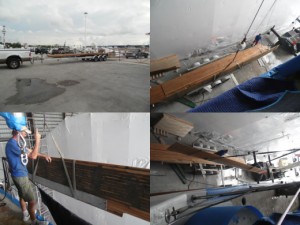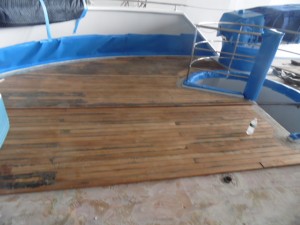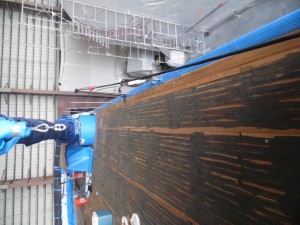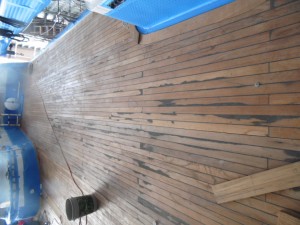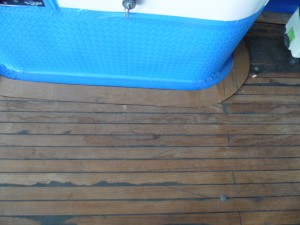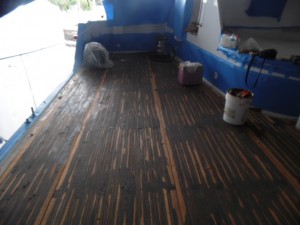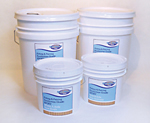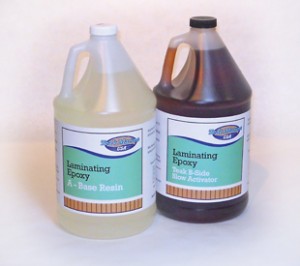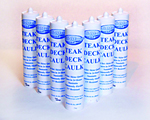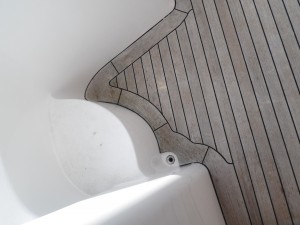
Before
Teak Decks are not only beautiful; they add a classic look to any yacht. They are admired for their rich color and aesthetically pleasing appearance. They tend to be a rich golden to medium brown color, but it is not uncommon for teak decks to prematurely age or weather over time due to poor maintenance as well as the elements. If not properly maintained you will find that your teak deck can quickly fade to a dull, silvery grey color.Teak is a durable, naturally oily wood; it can react negatively to hard bristles or abrasive chemicals such as two-part acid cleaners. For example, whilst most acid washes restore the teak to its natural golden color, they do so at the cost of stripping the wood of its natural oils, removing pulp from the grain as well as grime. This results in a dry and brittle deck. If improperly cleaned, the top layer of wood cells is removed with the dirt. Once the wood is gone, it is gone for good!
There is a tendency is for people to “over maintain” their teak decks by scrubbing them far too often with harsh, environmentally harmful two part acid cleaners and brighteners. These products cause notable wear and tear to the wood, weaken/comprise caulk seams and over time, significantly reduce the life of the deck. This may be popular with some teak companies; who will be more than happy to replace your decks or repair caulk failures due to premature as a result of the over use of caustic, environmentally harmful cleaners, but we do not recommend it.
MAINTAINING THE APPEARANCE OF YOUR TEAK DECKS:
Keeping exposed teak looking its best is challenging. The use of teak sealer’s such as Semco are becoming ever more popular, especially with small to medium size vessels. This durable protectant maintains a protective coating, eliminating the need for deep cleaning. Semco contains UV protection and a mildewcide. It applies easily, dries quickly, and provides a non-slip finish.
For those who prefer the natural exposed look of teak, they can either accept the natural gray patina that a teak deck will attain over time, or take steps to maintain the fresh cut teak look.
An old Sea Salt may advise you to clean your decks using good old fashioned sea water. This does indeed work. However, this process is extremely labor intensive, not to mention time consuming and as such, is not very practical.
There are a number of ‘environmentally friendly’ teak cleaners on the market, which have varying degrees of effectiveness. There are far too many of these products to review here, save to say that they cost significantly more than some household cleaners which provide similar, if not better results.
The best way to clean your teak deck is with a regular rinse of clean water. Do not spray the deck with high pressure hoses as this will damage the teak and compromise caulk seams. If washing is needed, we recommend that you use soap like Joy or Tide crystals with a cotton mop, and rinse well with hot water. If you have to scrub, do it across the grain with 3M Doodlebug, or similar time pad.
Be sure that you do not scrub too hard as the top layer of the wood cells can removed with the dirt. Remember that what goes away is gone and the wood on your deck will not come back.
The mildest teak cleaner is a general purpose household powdered cleaner such as Spic ‘n Span. A concentrated solution of powdered cleaner and scrubbing using a very soft bristle brush or, better yet, a 3M pad, will do a surprisingly good job on teak that is basically just dirty.
Don’t scrub any harder than you have to, and always scrub across the grain. Every time you scrub the teak, you are removing softer wood, which eventually results in an uneven surface that raises the grain. Regularly using a firm brush to scrub with the grain will lead to problems down the road.
The advantage of a gentle scrub using mild cleaners is that while it is more work for you, it is by far the most gentle for your teak. Since you are likely to have some powdered detergent around, always try this method before going on to more drastic measures.
Simply wet down an area with water, clean with the detergent solution, rinse with fresh water, and let it dry. If the wood comes out a nice, even light tan, you’re in luck. If it’s still mottled or grey, a more powerful cleaner is called for.
Even a badly weathered teak deck should come up reasonably well with a one part cleaner. When the wood dries, it should be a uniform light tan. If some areas are still grey, a repeat cleaning should do the job.
REMOVING MILDEW:
When tackling mildew on your, the best approach to preserving your teak decks would be to use a 50/50 solution of white vinegar and water. Scrub lightly to remove the mildew. If this fails to fully solve the issue you can lightly sand your teak decks with a high grit sandpaper, such as 60 grit.
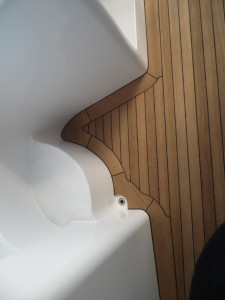
After

